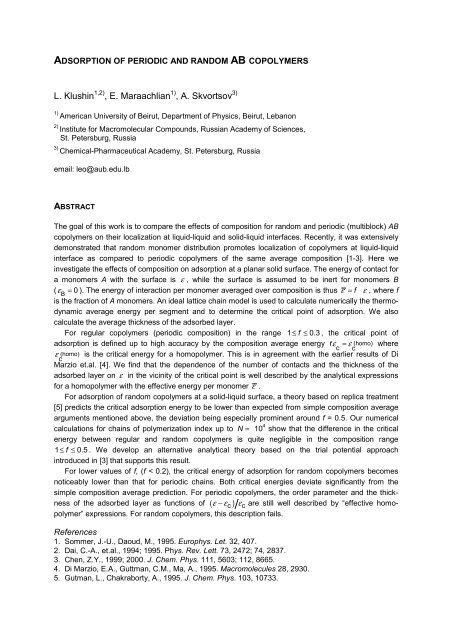Collapse of polymer brushes grafted onto planar ... - Wageningen UR
Collapse of polymer brushes grafted onto planar ... - Wageningen UR
Collapse of polymer brushes grafted onto planar ... - Wageningen UR
You also want an ePaper? Increase the reach of your titles
YUMPU automatically turns print PDFs into web optimized ePapers that Google loves.
ADSORPTION OF PERIODIC AND RANDOM AB COPOLYMERS<br />
L. Klushin 1,2) , E. Maraachlian 1) , A. Skvortsov 3)<br />
1) American University <strong>of</strong> Beirut, Department <strong>of</strong> Physics, Beirut, Lebanon<br />
2)<br />
Institute for Macromolecular Compounds, Russian Academy <strong>of</strong> Sciences,<br />
St. Petersburg, Russia<br />
3)<br />
Chemical-Pharmaceutical Academy, St. Petersburg, Russia<br />
email: leo@aub.edu.lb<br />
ABSTRACT<br />
The goal <strong>of</strong> this work is to compare the effects <strong>of</strong> composition for random and periodic (multiblock) AB<br />
co<strong>polymer</strong>s on their localization at liquid-liquid and solid-liquid interfaces. Recently, it was extensively<br />
demonstrated that random monomer distribution promotes localization <strong>of</strong> co<strong>polymer</strong>s at liquid-liquid<br />
interface as compared to periodic co<strong>polymer</strong>s <strong>of</strong> the same average composition [1-3]. Here we<br />
investigate the effects <strong>of</strong> composition on adsorption at a <strong>planar</strong> solid surface. The energy <strong>of</strong> contact for<br />
a monomers A with the surface is ε , while the surface is assumed to be inert for monomers B<br />
(ε = 0 ). The energy <strong>of</strong> interaction per monomer averaged over composition is thus ε = f ε , where f<br />
B<br />
is the fraction <strong>of</strong> A monomers. An ideal lattice chain model is used to calculate numerically the thermodynamic<br />
average energy per segment and to determine the critical point <strong>of</strong> adsorption. We also<br />
calculate the average thickness <strong>of</strong> the adsorbed layer.<br />
For regular co<strong>polymer</strong>s (periodic composition) in the range 1≤f ≤0.3,<br />
the critical point <strong>of</strong><br />
adsorption is defined up to high accuracy by the composition average energy f ε = ε (homo) where<br />
c c<br />
ε (homo) is the critical energy for a homo<strong>polymer</strong>. This is in agreement with the earlier results <strong>of</strong> Di<br />
c<br />
Marzio et.al. [4]. We find that the dependence <strong>of</strong> the number <strong>of</strong> contacts and the thickness <strong>of</strong> the<br />
adsorbed layer on ε in the vicinity <strong>of</strong> the critical point is well described by the analytical expressions<br />
for a homo<strong>polymer</strong> with the effective energy per monomer ε .<br />
For adsorption <strong>of</strong> random co<strong>polymer</strong>s at a solid-liquid surface, a theory based on replica treatment<br />
[5] predicts the critical adsorption energy to be lower than expected from simple composition average<br />
arguments mentioned above, the deviation being especially prominent around f = 0.5. Our numerical<br />
calculations for chains <strong>of</strong> <strong>polymer</strong>ization index up to N = 10 4 show that the difference in the critical<br />
energy between regular and random co<strong>polymer</strong>s is quite negligible in the composition range<br />
1≤f ≤0.5.<br />
We develop an alternative analytical theory based on the trial potential approach<br />
introduced in [3] that supports this result.<br />
For lower values <strong>of</strong> f, (f < 0.2), the critical energy <strong>of</strong> adsorption for random co<strong>polymer</strong>s becomes<br />
noticeably lower than that for periodic chains. Both critical energies deviate significantly from the<br />
simple composition average prediction. For periodic co<strong>polymer</strong>s, the order parameter and the thickness<br />
<strong>of</strong> the adsorbed layer as functions <strong>of</strong> ( ε − εс) εcare<br />
still well described by “effective homo<strong>polymer</strong>”<br />
expressions. For random co<strong>polymer</strong>s, this description fails.<br />
References<br />
1. Sommer, J.-U., Daoud, M., 1995. Europhys. Let. 32, 407.<br />
2. Dai, C.-A., et.al., 1994; 1995. Phys. Rev. Lett. 73, 2472; 74, 2837.<br />
3. Chen, Z.Y., 1999; 2000. J. Chem. Phys. 111, 5603; 112, 8665.<br />
4. Di Marzio, E.A., Guttman, C.M., Ma, A., 1995. Macromolecules 28, 2930.<br />
5. Gutman, L., Chakraborty, A., 1995. J. Chem. Phys. 103, 10733.

















